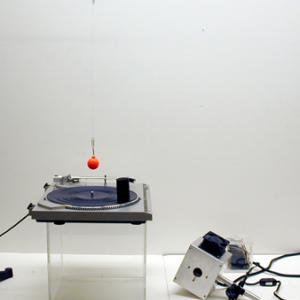College of Liberal Arts & Sciences
3A40.21 - SHM and Rotational Motion - Pendulum
Set the pendulum up so that it is directly over the center of the turntable. Place the painted wooden block at the edge of the turntable. When the needle arm is moved out of its carriage the turntable will start to rotate. Practice will be needed to be able to start the pendulum in phase with the rotating block on the turntable. The pinpoint light source is used to create a shadow graph of this on the screen in the lecture room.
The turn table is placed on top of the lazy susan. Slight differences in phase due to the slow release of the pendulum can be compensated for by rotating the turn table/lazy susan unit.
- Greg Jakovidis, "Demonstrating the Relationship Between Circular and Simple Harmonic Motion", TPT, Vol. 35, # 2, p. 177, Feb. 1997.
- Fr. Earl Meyer, " Simple Apparatus for Simple Harmonic Motion", TPT, Vol. 3, # 3, March 1965, p.127.
- David Kutliroff, "67, Simple Harmonic Motion Is Displayed by a Rotating Turn Table", 101 Classroom Demonstrations and Experiment For Teaching Physics, p. 148.
- Robert L. Wild, "SHM with Turntable and Pendulum", Low-Cost Physics Demonstrations, # 41, p. 27.
- Earl Meyer, "Simple Apparatus for Simple Harmonic Motion", Apparatus for Teaching Physics, p. 55.
Disclaimer: These demonstrations are provided only for illustrative use by persons affiliated with The University of Iowa and only under the direction of a trained instructor or physicist. The University of Iowa is not responsible for demonstrations performed by those using their own equipment or who choose to use this reference material for their own purpose. The demonstrations included here are within the public domain and can be found in materials contained in libraries, bookstores, and through electronic sources. Performing all or any portion of any of these demonstrations, with or without revisions not depicted here entails inherent risks. These risks include, without limitation, bodily injury (and possibly death), including risks to health that may be temporary or permanent and that may exacerbate a pre-existing medical condition; and property loss or damage. Anyone performing any part of these demonstrations, even with revisions, knowingly and voluntarily assumes all risks associated with them.
